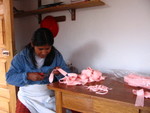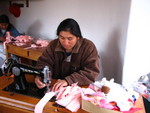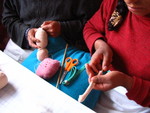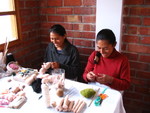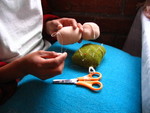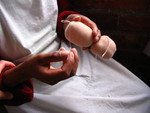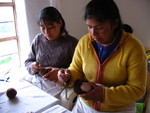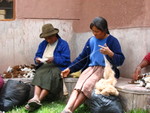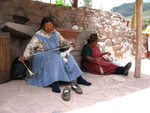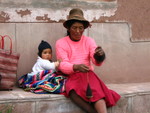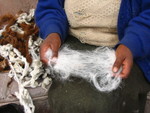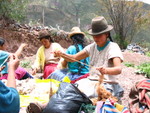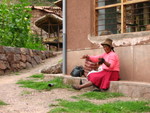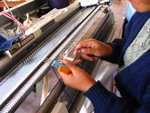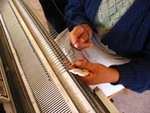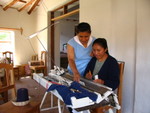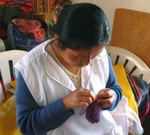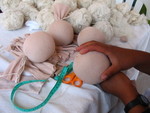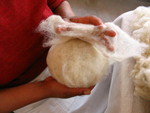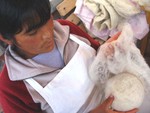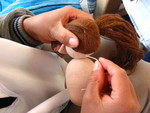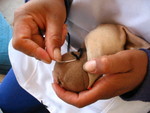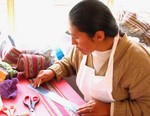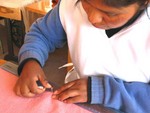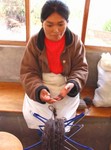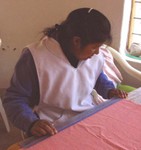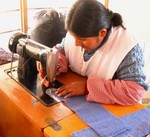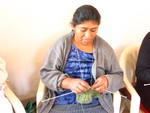The Doll Making Process
From the pure woolly innards to the finely crafted traditional clothing, a Q’ewar doll is a work of art from start to finish. It takes five days to craft a Q’ewar doll and the process starts with the cutting out of patterns for the head, body and limbs – from Peruvian cotton cloth.
After each part is cut, sewn and filled with clean sheep’s wool and possibly some alpaca, they are put aside, on reserve. Since the head and torso are one piece, the next step is the careful sewing in of the alpaca hair, strand by strand.
As some of you kind readers may know, there are several hair “styles” and the most time consuming coiffure is the curly haired boy.
At this stage, the doll is ready to be assembled after which the eyes and mouth can be gently sewn in. During the above labors, the seamstresses have been busy making lovely doll outfits for both boy and girl dolls – of Peruvian everyday wear as well as the traditional fiesta dress as worn today on special occasions.
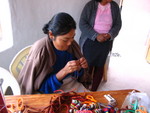
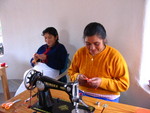
The last stage in the doll making process is the dressing of the dolls and the careful overview, thus ensuring quality control for each individual order.
Behind the scenes there is the intensive work of the spinning ladies who make the alpaca threads which are used to make doll booties, sweaters and little hats, as well as doll hair.
The weavers use traditional back strap looms and produce the fabric used in making ponchos and other accessories.
The sheep’s wool that is used for clothing must be cleaned, carded and sometimes dyed with natural tints. All these activities help support the doll making process.
Finally, at the end of this five day labor of love, the Q’ewar doll is ready for shipment, to find a new home and a pair of loving arms to care for it.
….From JoAnne, Q’ewar Doll Distributor in Vermont, USA
Dear Friends, When you buy one of our Waldorf Inspired dolls you are giving your support to the Q’ewar Project, a social and economic initiative working with the indigenous women living in a Quechua speaking village community in southern Peru. The women of the Q’ewar Project live in extreme poverty, and for most, this is the first chance they have had to learn skills to earn money in a humane and respectful working environment. Although the Project is young, the original intention – to provide an opportunity for these women to improve the difficult conditions of their lives – is bearing fruit, little by little.
About Q’ewar: It takes a whole village to create these beautiful, museum quality child-friendly dress up Q’ewar Waldorf inspired dolls! Homespun fibers and fabrics reflect a wide variety of traditional clothing and traditional skills of shepherding alpaca and sheep, carding, spinning, dyeing, weaving, knitting and embroidery. The combined qualities of imagination, color, and therapeutic work give rise to the healing environment in this women’s workshop located in the rural village of Andahuaylillas, Peru.
How You Can Help: If every community buys only two Q’ewar dolls it would make the world of difference! On behalf of the women and children of Q’ewar I thank you for considering this purchase. Proceeds contribute to the installation of water, electricity, and toilets in addition to providing a fair wage for labor. Please consider selling Q’ewar dolls in your community. The value of these dolls is well beyond the introductory purchase price.
A raffle, school store, holiday fair or other public event is a prime opportunity to spread word of Q’ewar further and to earn additional income above the purchase price for your community. Handwork and kindergarten teachers as well as students studying South America have loved seeing dolls made with authentic typical dress and Andean textiles.
Each Q’ewar doll is approximately 16 or 9 inches tall and made of natural fibers of alpaca, lamb’s wool and cotton. Girls have various hairstyles which can be undone and restyled easily. Both the boy and girl dolls have hair made from pure alpaca fiber. Colors range from very dark to reddish and blond.
Cotton dyed with a black tea wash gives a warm pigment to the skin.

